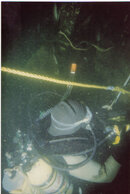SEI covers deco procedures using tables in Open Water class. Depending on what you mean by shallow. Since OW divers are suggested to limit their depths to 60 feet it seems that your examples fall into the advanced OW categories. I cover deco to the point that if one of my OW students never took advanced and merelyu extended their depths by experience and with a mentor they could plan a deco dive using the SEI tables which are based on the new Navy tables and include deco schedules to 130 feet with deco being done at 20 feet. Ranging from bottom times of 200 minutes at 40 feet to 30 minutes at 130 feet. So if one of my divers wanted to do a 60 foot dive for 70 minutes they would know how to use the tables to figure an ascent time of 1:20 to the 20 foot stop and then 23 minutes there.
I would of course not recommend this be done but if they had the gas and enough experience to make the dive then they would know how. I also would encourage them to take my advanced class where more procedures are covered along with gas management.
I would of course not recommend this be done but if they had the gas and enough experience to make the dive then they would know how. I also would encourage them to take my advanced class where more procedures are covered along with gas management.





 We also started extending our shallow stops because it made us feel better. We would even do a stop weather we needed one or not. This was before DAN gave it's blessing to safety stops.
We also started extending our shallow stops because it made us feel better. We would even do a stop weather we needed one or not. This was before DAN gave it's blessing to safety stops.

